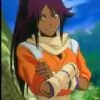Snake worship in Buddishm
Traditions about ngas are also very common in all the Buddhist countries of Asia. In many countries, the nga concept has been merged with local traditions of great and wise serpents or dragons such as the Burmese nat (Burmese: "; MLCTS: IPA: [na"]). In Tibetan religion, the nga was equated with the klu (Tibetan: ) that dwell in lakes or underground streams and guard treasure. In China, the nga was equated with the Chinese dragon (Chinese: ; pinyin: lng).
The Buddhist nga generally has the form of a great cobra, usually with a single head but sometimes with many. At least some of the ngas are capable of using magic powers to transform themselves into a human semblance. In Buddhist painting, the nga is sometimes portrayed as a human being with a snake or dragon extending over his head.[14] One nga, in human form, attempted to become a monk; when telling it that such ordination was impossible, the Buddha told it how to ensure that it would be reborn a human, able to become a monk.[15]
Nagas on copper pillar in Kullu, H.P., India
In the "Devadatta" chapter of the Lotus Sutra, the daughter of the dragon king, an eight-year-old longn (nga), after listening to Majur preach the Lotus Sutra, transforms into a male Bodhisattva and immediately reaches full enlightenment.[16][17][18] This tale appears to reinforce the viewpoint prevalent in Mahayana scriptures that a male body is required for Buddhahood, even if a being is so advanced in realization that they can magically transform their body at will and demonstrate the emptiness of the physical form itself.
Nagas are believed to both live on Mount Meru, among the other minor deities, and in various parts of the human-inhabited earth. Some of them are water-dwellers, living in streams or the ocean; others are earth-dwellers, living in underground caverns.
The ngas are the servants of Virpka (Pli: Virpakkha), one of the Four Heavenly Kings who guards the western direction. They act as a guard upon Mount Sumeru, protecting the d"vas of Tryastria from attack by the asras.
Among the notable ngas of Buddhist tradition is Mucalinda, Ngarja and protector of the Buddha. In the Vinaya Sutra (I, 3), shortly after his enlightenment, the Buddha is meditating in a forest when a great storm arises, but graciously, King Mucalinda gives shelter to the Buddha from the storm by covering the Buddha's head with his seven snake heads. Then the king takes the form of a young Brahmin and renders the Buddha homage
It is noteworthy that the two chief disciples of the Buddha, Sariputta and Moggallna are both referred to as Mahnga or "Great Nga". Some of the most important figures in Buddhist history symbolize nagas in their names such as Dignga, Ngrs"na, and, although other etymons are assigned to his name, Ngrjuna.
In the Vajrayna and Mahsiddha traditions nagas in their half-human form are depicted holding a naga-jewel, kumbhas of amrita, or a terma that had been elementally encoded by adepts.
Norbu (1999: p.?) states that according to tradition, the Prajapramita terma are held to have been conferred upon Ngrjuna by the Nagaraja, who had been guarding them at the bottom of a lake.






























